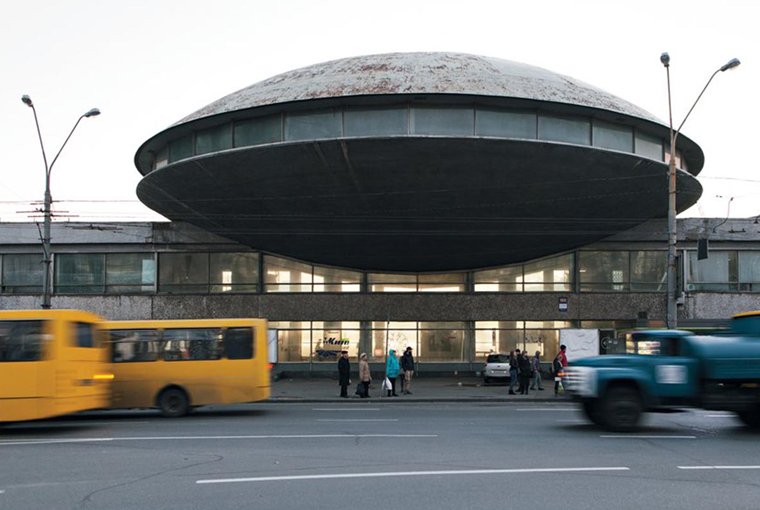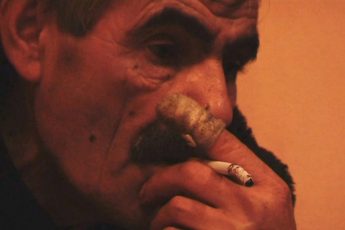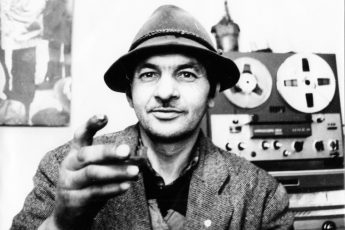The Cantilever City
Brutalist Architecture in (Soviet) Cinema
Vol. 113 (March 2021) by Esen Gökçe Özdamar
Brutalist architecture prevailed in post-war England in the 1950s and spread, during the 1960s and 1970s, to Asia, North America and the Soviet bloc. This radical architectural style – predominantly made of concrete – soon reshaped high-tech public and private buildings, monuments and even parks in both urban and rural areas. In the Soviet bloc, cantilever and monolithic architecture became an integral part of expressive brutalism, whose origins can be traced back to the constructivist experiments of the 1920s and 30s. The raw concrete that was used in brutalist architecture initially stood for durability. Imposing, monumental and sometimes extravagant, the new style embodied political confidence and authority. However, it also came to unveil one of the Soviet Union’s most fundamental contradictions. While the complex futuristic structures still had an ultimate public purpose, aesthetically they sacrificed the socialist principles of collectivist uniformity and productive standardization.
Although brutalism was widely used in Soviet architecture, including for the construction of cinema halls, it was hardly visible in Soviet films. This is especially true for cantilever architecture. As a free-end beam, the cantilever most conspicuously displayed the growing tensions at the heart of the Socialist project. On the one hand, the cantilever is a gravity-defying structure, built over an unfinished space. This floating element leaves room for openness, utopia and revolution, elements highlighted by the mastery of dynamic concrete shapes. On the other hand, the imposing free end of the cantilever is also a suppressor, creating a strange fragility. It could collapse at any moment. It is in this later sense that cantilever architecture resonated in the Western cinema of the time and in that it survives in today’s ruin cinema.
Nevertheless, generally speaking brutalism had relatively little impact on Western and Soviet cinema, especially when compared with modernist architecture, which figured prominently on the big screen. King Vidor’s The Fountainhead (1949) championed modernism for its individualist promise, entrepreneurial vision and technological progress, and Jacques Tati’s Mon Oncle (1958) ridiculed it for the same reasons. Brutalist architecture, on the other hand, did not seem to enjoy a similar standing and artistic treatment. In visual culture it was, instead, documented by photography – usually in black and white, to underscore its dramatic and imposing qualities. Despite brutalist architecture being one of the most important movements in Soviet architecture, it is thus striking to note its absence from Soviet cinema. This article focuses on the cinematic representation of brutalist architecture or, rather, investigates why the cantilever, unlike other hallmarks of Soviet architecture such as the khrushchyovka, never managed to figure as a prominent cinematographic setting. It explores how brutalism’s visibility and representation in cinema can contribute to our perception of space and visual culture. In this context, the cantilever city is evaluated as one of the extensions of brutalist architecture and analyzed in terms of an alienating urban landscape that requires being treated with distinct montage and narrative techniques.
In modern architecture, the material of concrete became an obsession for many architects due to its plasticity, affordability and surface quality. In the second half of the twentieth century, “rough concrete” was used in brutalist architecture, from which it derives its name (“béton brut” meaning “rough concrete”). Essentially, it just meant to remove the white plastered face of modern architecture, making the raw material visible.1 With brutalism, the structural properties of concrete became “weightless and infinitely plastic”.2 Today, publications such as SOS Brutalism, Atlas of Brutalist Architecture, This Brutal World, How to Love Brutalism, Soviet Bus Stops and organizations such as DOCOMOMO aim at documenting the brutalist architectural heritage.
The beginnings of brutalism began in 1949 when Hans Asplund visited Villa Göth, a brick building designed by Bengt Edman and Lennart Holm Ashland in Upsala. According to Asplund, the house was impressive because of its “bloody-mindedness”, and so he called it “nybrutalism” (“the new brutal”).3 Later, the term “New Brutalism” was coined by British architects Alison and Peter Smithson when describing a housing project in Soho.4 The Smithsons designed a school building showing traces of brutalism in Hunstanton, Norfolk in 1949-1954, and in the 1950s they designed a housing project for a London bomb site.5
The birth of brutalism cannot be regarded as accidental; the independent and artificial nature of modern architecture creates a strong contrast between what is “natural” and what is “designed” in a building. In this binary logic, design is criticized for alienating the material construction process from its natural origins. Brutalism reverse-engineered this process of alienation in two ways. Materially, it used raw concrete (“béton brut”) and so did not alter or hide its components. Symbolically, it epitomized affordable housing. Large residential complexes and public housing developments were both a “futuristic and primitive” material after World War II.6 Architectural critic and historian Reyner Banham later spoke of brutalism as the “architecture of massive plasticity and coarse surfaces”.7 His 1955 essay “The New Brutalism” characterized the Hunstanton School as the first brutalist building.8 According to Banham, the movement had certain key characteristics: “a unified visual image”, “a clear exhibition of its structure,” and “a high valuation of raw, untreated materials”.9 However, brutalism was not only about appearance or “surface qualities”, it also means expressing the “tangibility of experience”, meaning that the honest and generic qualities of the buildings were not only to be admired, but also to be lived.10 By the 1980s these ideas were upended. Maintaining brutalist buildings proved to be very costly, the raw concrete was not resistant to weathering, and the visible water damage and decay brought down the overall aesthetic. In many countries, brutalism also came to be associated with totalitarianism and authoritarian power – an architecture of evil. Once a hallmark of social progress, it came to represent decay: the material decay of its substance, and the symbolic decay of social democracy. And so brutalism waned.
Although brutalist forms can be recognized in some dystopian science fiction films, ‘brutalism’ bears an altogether different meaning in cinema studies, where it most often refers to the increasing realism in the depiction of violence in films of the 1990s.11 That is perhaps why cinema viewers associate brutalist architecture with violence. Indeed, “brutality” in the sense of “cruelty, inhumanity, and aggression” is pervasive in films with a brutalist setting.12 In the Western cinematographic tradition, brutalist architecture is thus often framed in crushing dystopian visions, such as in the neo-noir science fiction movie Blade Runner 2049 (2017) by Denis Villeneuve, which is set in a futuristic and brutalist London. Dark, cold, and alienating concrete settings are the defining characteristics of the brutalist set design, as can be seen in films such as Stanley Kubrick’s Dr. Strangelove or: How I Learned to Stop Worrying and Love the Bomb (1964), Jean-Luc Godard’s Alphaville (1965), Stanley Kubrick’s A Clockwork Orange (1971), Jacques Tati’s Trafic (1971), Mike Hodges’s Get Carter (1971), Michael Radford’s Nineteen Eighty-Four (1984), in the TV-series Misfits (2009-2013), in the brutalist city of Panem in The Hunger Games (2012), and in Ben Wheatley’s High Rise (2015). Brutalism is most strikingly conflated with brutality in Get Carter, which uses Owen Luder’s Trinity Square parking “as an indicator of social disorder and a precursor to violence”.13 Brutalism’s relationship with science fiction can be linked to the “destructive power and the horrors of the war”. The abundance of bunkers and military concrete architecture “projected the collective anxieties of the Cold War era” onto the screen.14
Perhaps nobody has explored the dystopian aspects of the brutalist setting more thoroughly than Stanley Kubrick in his science fiction movie A Clockwork Orange. The film takes place in London’s remote and vast Thamesmead Mansion and on the Binsey Walk in the Flat Block Marina, where Alex and the Droogs confront the realities of violence. State power and punishment takes place in the Ludovico Medical Facility, the cubic cantilevered lecture building of Brunel University that was designed by Richard Sheppard and John Stallman. According to Hatherley, “a signifier of Modernism becomes perverse and violent, brutalism in the material sense transliterated into physical brutality. The building – white-grey concrete point blocks linked by walkways to lakes and futuristic low-rise maisonettes – seem as cold, stylish and psychotic as Alex and his Droogs” (Figure 1).15 This film has set the standard for films like Blade Runner or The Hunger Games.

In these films, brutalist buildings create a space in which a singular edifice is not represented in its real urban setting, that is together with non-brutalist buildings, places, and roads. Large geometric surfaces and rows of concrete appear to reach far out of the frame, giving the impression of a massive uninterrupted space. Modular elements, too, no longer adhere to a single building block but to the entire urban landscape. Built on the illusion of continuity, editing allows these films to construct entire cantilever cities. Cinema thus manages to create the utopian vision of the brutalist project, the “unified visual image” quoted above, only to subvert it and reveal its dystopian qualities. Indeed, the visions of endless concrete are all but unifying. Instead they embody an overpowerful government. In this gloomy setting, brutalism is also removed from its intended “natural” quality, conveying instead a feeling of alienation and uprootedness. By revealing its dull, artificial and oppressive qualities, visual culture starting in the 1970s and 80s thus echoed, if not contributed to, the decline of brutalism in the West, setting the stereotype for brutalism as an architecture of evil that survives to this day.
In the Soviet Union, brutalist architecture was inspired by expressionism, science fiction, early European modernism and the Russian Suprematism “to produce an idiosyncratic, flamboyant and often imaginative architectural menage”. In contrast to their environment, brutalist buildings “stand in stark contrast to the stereotypical understanding of late Soviet architecture in which monotonously repetitive urban landscapes were punctuated by vulgar exercises in architectural propaganda”.16 Brutalism thus had a somewhat different impact on Soviet architecture than in other countries, and in the 1920s it found more space in the work of Russian constructivists with avant-garde and unconventional approaches. Indeed, works built by Russian constructivists and the paper architects of the 1920s designed cantilever structures of bold, large structural designs, such as El Lissitzky’s 180-meter-long-slab and 50-meter-high “Wolkenbügel” (“cloud hangers”) in Moscow (1924). Other examples are the “Lenin Tribune” (1920), Vladimir Tatlin’s “Monument to the Third International” (1919), Konstantin Melnikov’s projects and pavilions, Iakov Chernikhov’s “Architectural Fantasies” illustrations, and Popova and Vesnin’s theater set designs.17 In fact, in the 1920s, Russia became an experimental playground for concrete construction. These cantilever structures were vertically oriented organizations.
Such free and expressive forms could only fit into communist ideology because they embodied revolutionary outbreak, the political utopia justifying the anti-functionalist elements. Under Stalinism, constructivism was forbidden along with other avant-garde movements. Under a severe housing crisis, a functionalist version of brutalism reemerged in the post-War era and the imaginative forms of the constructivist period did not resurface until the mid-to-late 1970s.18 It is difficult to understand why filmmakers refrained from constructing a scenery that borrowed from the constructivist heritage. Perhaps the forms were simply too open for the dictates of centralized planning, which tried to cram as many people into the smallest space possible, in the shortest amount of time.
Nevertheless, by the end of the 1970s the constructivist tradition was firmly revised. The socialist and communist governments of the Soviet bloc set up hundreds of government buildings, science laboratories, and a vast variety of constructions ranging from sports fields to monuments. The “Telecommunications Center” designed by Janko Konstantinov in Skopje, Macedonia in 1974 and the “Buzludzha Monument” designed by Guéorguy Stoilov in Bulgaria, are some of the concrete brutalist examples of Soviet modernism. Many of these buildings are abandoned today. For example, the “Institute of Scientific and Technical Information”, designed by L. Novikov and F. Yuriev in Kiev in 1974, which looks like an alien space-ship made of concrete, is in a state of ruin. The modernist bus stops in Soviet architecture are also in very bad shape (Title Photograph, Figure 2).

And yet, still none of these buildings could be seen on the screen. While Soviet films of this period started to criticize the prefabricated concrete panels (e.g. Eldar Ryazanov’s Irony of Fate), the critique of the cantilever city that could be observed in Western cinema never materialized in Soviet cinema. This may have been because in the Soviet vision, elements of expressive brutalism such as the cantilever were antithetical to the alienating dystopia they represented for the West. Today visual culture in the former Eastern bloc has fetishized the decaying buildings in ruin cinema. However, far from insisting on the oppressive and overpowering characteristic of these buildings through montage, ruin cinema tries to capture their sculptural beauty. In this aesthetic, the buildings are preserved and documented, and the geometrical forms heightened to convey a sense of abstract beauty. Where Western cinema reassembled the brutalist setting to express dystopian fear, ruin cinema opens the space for utopian nostalgia.
It is no coincidence that a majority of films featuring brutalist architecture in the region are documentaries. In the short documentary film Soviet Modernism, Brutalism, Post-Modernism: Buildings and Projects in Ukraine Between 1960-1990 (2018), director Roman Blazhan traces brutalist architecture in the Ukraine. The ARTE documentary Belgrade: A Brutalist Jewel about a skyscraper built in 1977 describes the building as “the ugliest building in the world” while at the same time the title refers to it as a “jewel”. Here the ugliness of the decaying building gets its value from sentimental reminiscences. The ARTE documentary Bulgaria: UFO of Communism (2019) about Georgi Stoilov’s Buzludzha Monument 1987-1981 proceeds in the same vein. The documentary format more adequately preserves the monolithic character of the buildings. There is a sharp contrast between the edifice, the human-designed world, and nature or the surrounding environment. As isolated sculptures, the buildings represent a kind of inaccessibility and loneliness of modern human beings living in an artificially constructed environment. Alienation, here, resurfaces not in its oppressive Marxist variant, but as a romantic predicament: sadness over lost dreams.
Although cantilever structures were widely used in Soviet architecture in an attempt to re-enforce the architectural narrative, they were hardly shown in Soviet cinema. As a symbol of dystopia, the cantilever has been associated with literal brutality in Western cinema. Here montage techniques efficiently reassemble cantilever structures into endless urban landscapes symbolizing social and political violence. In Soviet cinema, it is argued, the cantilever could never be deployed in this dystopian way because of its indebtedness to constructivism, where it embodied revolution and artistic freedom. In the political climate of the post-war Soviet Union, which prioritized collectivist uniformity in society as well as in architecture, a symbolic danger thus emanated from depicting these buildings. In contrast, today’s popularization of cantilever structures comes mainly from the perspective of architectural heritage, which makes use of documentary forms to recast the decaying edifices into a form of transient beauty.
References
- 1.Williams, T. & Tsien, B. (2006). “Surface as substance.’’ In: J.L. Cohen, & G. Martin Moeller, Jr. (Ed.), Liquid Stone. New York: Princeton Architectural Press, 106-108.
- 2.Denari, N. M. (2010). “Concrete Becoming Plastic, Then Graphic.’’ In: C. Buckley, & M. Bell (Ed.), Solid States: Concrete in Transition. New York: Princeton Architectural Press, 267-271.
- 3.Mould, O. (2017). “Brutalism Redux: Relational Monumentality and the Urban Politics of Brutalist Architecture.’’ Antipode 49 (3), 701-720.
- 4.Kitnick, A. (2011). “New Brutalism: Introduction.’’ October, 136, 3-6.
- 5.Mould, O. (2017), Ibid., 703.
- 6.Brockington, R., & Cicmil, N. (2016). “Brutalist architecture: An autoethnographic examination of structure and corporeality.’’ M/C Journal, 19 (1). Retrieved on August 25, 2020 from http://journal.media-culture.org.au/index.php/mcjournal/article/view/1060. See also Hatherley, O. (2008). Militant Modernism. Washington, D.C.: Zero Books.
- 7.Banham, R. (1966). The New Brutalism, Ethic or Aesthetic. London: Architectural Press, 47.
- 8.Banham, R. ([1955] 2010). “The new brutalism’’. Architectural Review. Retrieved on June 11, 2020 from https://www.architectural-review.com/archive/the-new-brutalism-by-reyner-banham/8603840.article. Originally published in AR December 1955.
- 9.Banham, R. (1966), Ibid., 126.
- 10.Denari, N. M. (2010), Ibid., 267. Later, in the post-war period, brutalism that spread to many countries in Europe and Soviet countries such as Russia, Bulgaria, Yugoslavia and Czechoslovakia was “influenced by socialist ideals’’, resulting in “utilitarian, austere and soulless but low cost’’ buildings (Architecture and Design, 2019). Brutalist architecture has become the “symbol of sincerity and straightforwardness’’ as it shows how the “building was built’’ and “stages of the construction process’’. See Niebrzydowski, W. (2019). From `as found’ to Bush-hammered Concrete–material and Texture in Brutalist Architecture. IOP Conference Series: Materials Science & Engineering, February 2019, 471 (7), 1-9, 3.
- 11.Barker, M., & Petley, J. (Eds.). (1997). Ill Effects: The Media Violence Debate. Routledge, 146.
- 12.Collard, P. (2018). “Concrete on Film: Exploring Brutalist Architecture on Screen from Columbus to A Clockwork Orange’’, 18 October, 2018. Retrieved on June 11, 2020 from https://www.wallpaper.com/art/brutalism-on-film.
- 13.Collard, P. (2018). Ibid.
- 14.Grozdanic, L. (n.d.). “Architecture at the Movies: Why Brutalism is the Real Star in Spy Films.’’ Retrieved on June 11, 2020 from https://architizer.com/blog/inspiration/stories/spy-films-and-the-thrilling-joylessness-of-brutalism/.
- 15.Hatherley, O. (2008). Ibid, 99-100.
- 16.CCCP (Cosmic Communist Constructions Photographed, Exhibition) (2007). New York: Storefront for Art and Architecture.
- 17.Pare, R. (2007). The Lost Vanguard: Russian Modernist Architecture 1922-1932. New York: The Monacelli Press, 6.
- 18.Pare, R. (2007), Ibid.




Leave a Comment